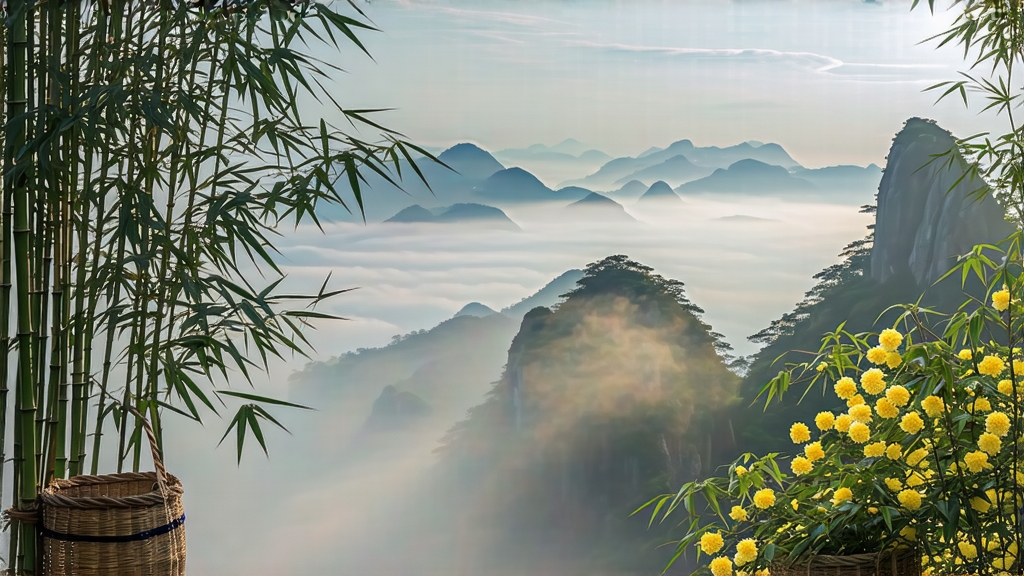
Tucked high in the mist-veiled Dabie Mountains of western Anhui Province, Huoshan Huangya has quietly embodied the elegance of China’s least-understood tea category for more than fourteen centuries. While green tea commands global fame and pu-erh dominates investment circles, yellow tea—huang cha—remains a whispered legend even inside China. Among the handful of authentic yellow teas still crafted, Huoshan Huangya is the most venerable, the first to be entered into the Tang Dynasty’s “Cha Jing” and the last to disappear from the Forbidden City’s tribute rolls in 1908. This article invites the international tea lover to discover why emperors once guarded its secrets, how a unique “menhuang” microbial seal turns green leaf into liquid topaz, and what steps will coax its apricot-sweet aroma from gaiwan to glass.
-
Historical tapestry
According to the county gazetteer of Huoshan, Buddhist monks at the Bamboo-Wisdom Temple began pressing and steaming local mountain tea in 627 CE, presenting the resulting “yellow cake” to Emperor Taizong. The compressed bricks were easier to transport along the Han River to Chang’an than loose leaf, and the extra moisture left the tea subtly yellowed, softer on the stomach than raw green tea. By the Song era the bricks had given way to loose strips, but the name Huangya—“yellow sprout”—stuck, referring to the pale golden down that clothes each early-spring bud. During the Ming and Qing dynasties the magistrate of Huoshan was required to deliver 300 liang (roughly 11 kg) of the finest Huangya within ten days of Qingming festival; failure meant dismissal. Legend says the Qianlong Emperor refused all other teas when reviewing naval blueprints in the Summer Palace, claiming Huangya “cleared the eyes for distant strategy.” After the fall of the Qing, imperial demand vanished, and the intricate menhuang craft nearly vanished with it. Only a few mountain families kept the art alive during the 1930s–1980s, passing it from mother to daughter under the bamboo eaves. Today, protected by both a China-origin GI (Geographical Indication) and a provincial intangible-cultural-heritage status, Huoshan Huangya is staging a cautious renaissance. -
Terroir and cultivar
Huoshan County lies at 31° N, 800–1,200 m above sea level, where the Dabie range funnels cool clouds between the Yangtze and Huai River watersheds. The mean annual temperature is 15 °C; diurnal swings of 10–12 °C in April slow the sprouting of tea bushes, concentrating amino acids. Soils are acidic yellow-brown loam rich in kaolin and quartz, providing sharp drainage yet holding enough moisture for the ancient seed-grown population known locally as “Jin Ji Zhong” (“golden chicken heart”), a small-leaf, late-budding landrace that naturally contains 5.2 % L-theanine and only 8 % catechins—ideal for the gentle oxidation that follows. Above 1,000 m, wild camphor and bamboo filter 30 % of sunlight, prompting the bushes to produce more chlorophyll-b and carotenoids, precursors to the honeyed aroma that emerges during menhuang. -
Plucking calendar
Authentic Huangya is picked in a ten-day window after the spring equinox, when the bud is still a “sparrow’s tongue” (12–15 mm) and the first leaf is just unfurling. Experienced pickers use a twisting motion to snap the bud free without the woody stem, dropping it into a shallow bamboo “yu lou” (fish basket) lined with fresh fern fronds to prevent compression. The daily harvest ends at 10 a.m., before mountain mists lift and the leaf temperature rises, ensuring minimal enzymatic activity on the walk back to the village workshop. -
Crafting: the secret of menhuang
Yellow tea’s identity rests on a post-fixation “sealing and smothering” stage called menhuang—literally “yellowing.” The process is deceptively simple, yet timing and microclimate separate mediocrity from transcendence.
Step 1: Sha Qing (kill-green)
Buds are tumble-fired in bamboo-lined drums at 160 °C for 3.5 minutes, just enough to denature polyphenol oxidase while